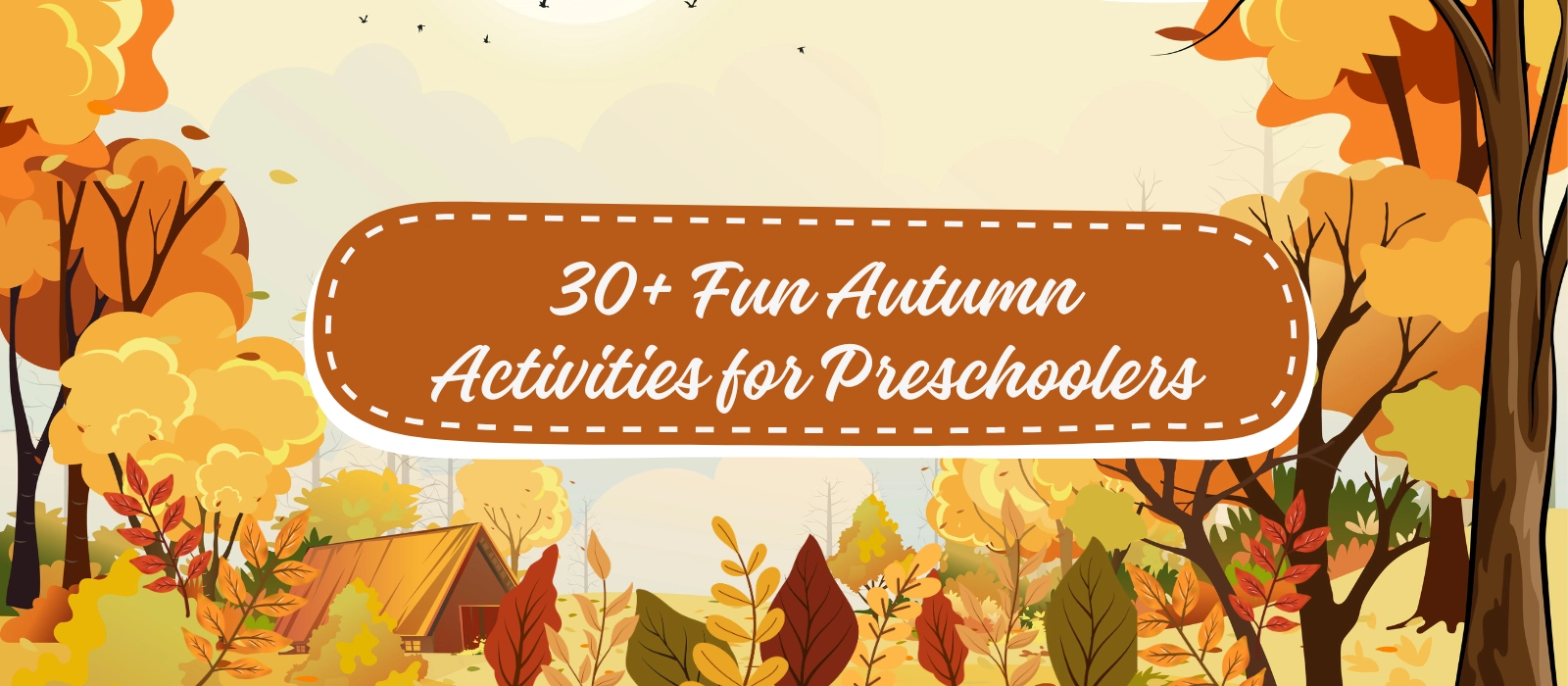Are your preschoolers full of energy this fall? Struggling to come up with engaging and educational autumn activities for preschoolers? Do you want to combine learning with fun while making the most of the crisp air, colorful leaves, and natural materials that autumn offers?
Autumn is the perfect season for preschool activities that spark creativity, promote developmental skills, and connect children with the natural world. Engaging in autumn activities for preschoolers not only helps enhance fine motor skills and sensory development but also integrates early literacy, math, and science in a playful way. These seasonal activities give educators and caregivers an excellent opportunity to reinforce classroom goals while giving children a sense of wonder and exploration.
Keep reading to discover over 30 hands-on, creative, and easy-to-implement autumn activities for preschoolers. Whether you run a kindergarten, manage a preschool classroom, or are a parent looking to enrich your child’s learning at home, these ideas will transform fall into a season of discovery and growth.
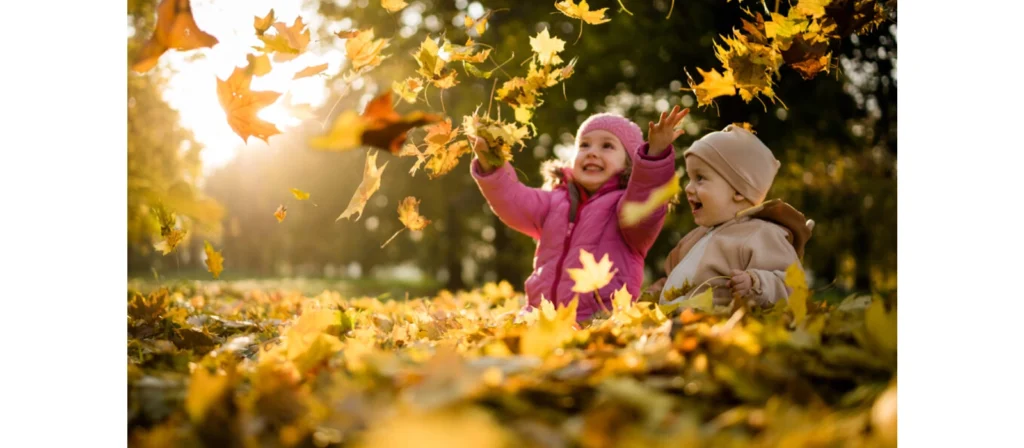
What Are the Benefits of Autumn Activities for Preschoolers?
Engaging preschoolers in autumn-themed activities isn’t just seasonal fun—it serves as a powerful tool for early childhood development. Autumn activities for preschoolers offer a natural gateway to sensory exploration, cognitive growth, and emotional learning. As children explore crunchy leaves, colorful pumpkins, and cooler weather, they’re also developing vital foundational skills.
Sensory Integration
Autumn’s visual and tactile richness enhances sensory integration. Children naturally respond to textures, temperatures, and colors. Rubbing leaves, painting pumpkins, or simply walking on a leaf-covered path stimulates their tactile and visual senses, contributing to stronger sensory processing.
Fine Motor Skill Development
Autumn activities support fine motor development. Whether threading acorns onto yarn, using tongs to sort apples, or gluing leaves into a collage, preschoolers strengthen the small muscles in their hands and fingers—skills essential for future writing and self-care tasks.
Language and Communication
Fall activities encourage language development and communication. Talking about seasonal changes, storytelling based on nature walks, or describing the smell of cinnamon all help expand vocabulary and improve verbal expression.
Math and Science Foundations
Autumn is perfect for early math and science learning. Through counting acorns, sorting leaves by color or size, graphing apple preferences, or making predictions about weather changes, young children begin to grasp logical thinking and data interpretation.
Social-Emotional Growth
Autumn activities encourage social-emotional learning. Group scavenger hunts, dramatic play as forest animals, and working on a large collaborative fall mural all foster sharing, teamwork, empathy, and classroom cohesion.
In short, the educational and developmental benefits of autumn activities for preschoolers make this season a treasure trove of opportunities for hands-on learning and joyful discovery.
Autumn Art Activities for Preschoolers
Art activities during fall offer an ideal platform for preschoolers to explore seasonal colors, textures, and materials. These projects stimulate creativity, build confidence, and help children express their observations of the natural world around them.
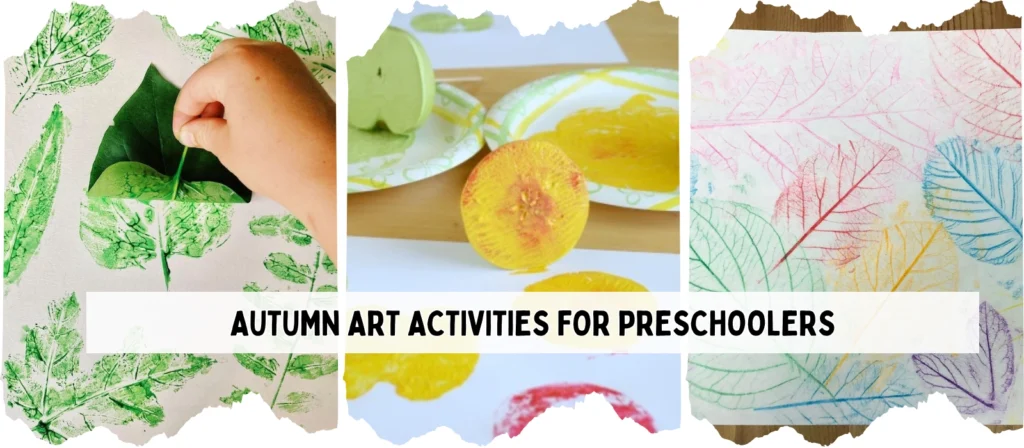
🍁 Leaf Stamping Art
Children collect fallen leaves and use them as stamps to create vibrant art on paper. This activity not only celebrates nature but also introduces the concept of symmetry and texture. It’s one of the most loved autumn activities for preschoolers.
- Materials: A variety of leaves, washable paint, thick paper, paintbrushes or sponges, aprons
- Steps: Take children on a nature walk to gather leaves. Let them paint one side of the leaf with a brush or sponge. Then press the painted side onto paper. Children can use different leaves and colors to create layered patterns or even design a forest scene. Encourage discussion about leaf shapes and colors during the process. This repetitive stamping builds both hand-eye coordination and excitement.
🍎 Apple Print Painting
Sliced apples become natural stamps for autumn-themed prints. This classic activity connects with seasonal produce and explores shapes and repetition in art. It is an ideal autumn activity for preschoolers that also introduces them to food textures.
- Materials: Apples (cut in half), trays of non-toxic paint, large white paper, aprons or old shirts
- Steps: Prepare the apples by cutting them horizontally to reveal star-like seed patterns. Dip the flat surface into paint, then press onto paper. Children can decorate their apple prints with faces, turn them into pumpkins, or mix colors to see different effects. Talk about where apples come from and include a short story or poem about apple picking. This helps integrate seasonal storytelling into art.
🍂 Crayon Leaf Rubbings
This sensory-rich activity allows children to explore leaf veins, outlines, and textures while practicing observation and fine motor skills. As one of the more relaxing autumn activities for preschoolers, it supports quiet-time engagement.
- Materials: Fresh or dried leaves, white paper, unwrapped crayons in fall colors
- Steps: Place leaves underneath the paper. Have children rub the side of the crayon gently over the top. As the patterns emerge, guide them in identifying types of leaves or the direction of the veins. Children can turn these rubbings into greeting cards or nature books. Use this opportunity to introduce vocabulary such as “stem,” “vein,” and “texture.”
🌿 Nature Collage
Using natural objects to form pictures fosters creativity, planning, and an appreciation for nature’s diversity. This is a collaborative autumn activity for preschoolers that enhances both language and cooperative play.
- Materials: Bark, sticks, leaves, acorns, seeds, pinecones, glue, cardboard or thick paper
- Steps: After collecting a range of items during outdoor play, children choose a theme (animal, tree, abstract art). They glue their materials to create a textured collage. Teachers can guide a discussion about each object’s texture, smell, or where it came from. Children can name their pieces and describe their story, building narrative skills.
🌽 Corn Mosaic Art
Creating mosaic art with dried corn helps children explore color patterns, concentration, and tactile experience. This is one of the most sensory-focused autumn activities for preschoolers.
- Materials: Dried corn kernels (plain or dyed in fall colors), glue, pencils, paper plates or cardstock
- Steps: Children draw simple shapes like pumpkins or acorns. Then, using glue, they fill the areas with corn kernels, focusing on pattern, color grouping, or outlines. This activity is great for working in small groups, helping children practice turn-taking and cooperative work. Teachers can extend the project by counting kernels or discussing patterns.
🎨 Fall Color Mixing Painting
This painting activity helps children understand primary and secondary colors while connecting the results to fall foliage. It’s a creative autumn activity for preschoolers that blends art with science.
- Materials: Red, yellow, and blue paint, paint trays, brushes, white paper, smocks
- Steps: Begin with a quick demonstration of how red and yellow make orange. Let children mix their own paints and paint trees, leaves, or abstract art. Ask open-ended questions: “What happens if we add more red?” or “Can you paint the leaf you saw outside?” This turns the painting into a scientific and artistic exploration. Let children name their colors or give titles to their artwork, enhancing language development.
Autumn Math Activities for Preschoolers
Math doesn’t have to be all worksheets and flashcards—especially in autumn. With the abundance of natural materials and visual themes, there are countless ways to turn fall into a hands-on math lab. These autumn activities for preschoolers introduce foundational math concepts through play, nature, and creativity.
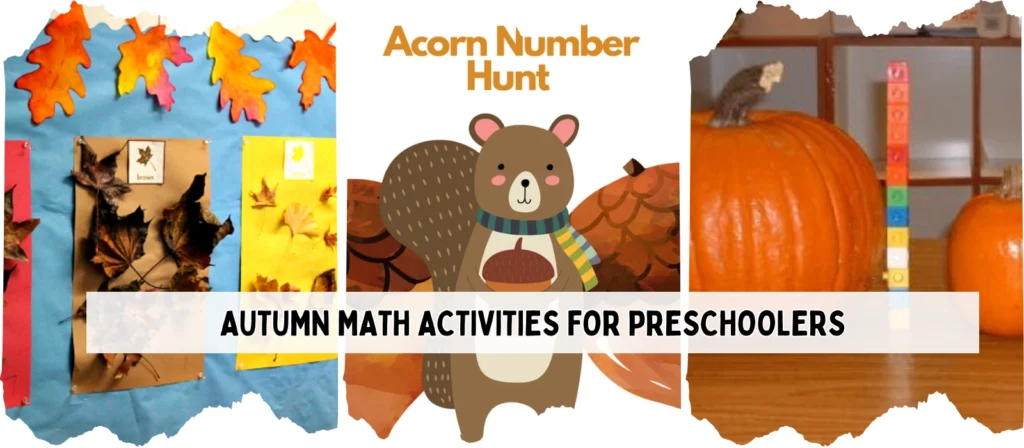
🍂 Sorting Leaves by Size or Color
This simple sorting activity introduces classification, comparison, and visual discrimination.
- Materials: Various types of leaves in different sizes and colors, sorting trays, labels, magnifying glasses
- Steps: Begin with a walk outside and let the children collect leaves. Once back indoors, present trays labeled with size or color categories. Ask children to sort their leaves accordingly, discussing their reasoning. Enhance the lesson with a sorting chart, allowing kids to count how many leaves are in each category. This develops both math language and group discussion skills.
🍎 Apple Counting Game
An engaging way to practice counting, number recognition, and one-to-one correspondence.
- Materials: Mini apples or red pom-poms, number cards, tongs or spoons, egg cartons
- Steps: Place number cards in front of children and ask them to count and transfer the corresponding number of apples into egg carton sections using tongs. This builds number recognition and fine motor strength. Extend the game by incorporating simple addition: “You have 2 apples. Add 1 more. How many now?” This approach connects early math operations with a seasonal theme.
🌰 Acorn Number Hunt
Great for combining physical activity with number recognition and sequencing.
- Materials: Acorns with numbers written on them, baskets, number line chart
- Steps: Hide acorns numbered 1–10 around the play area. Invite children to find and collect them. Once found, children arrange them on a floor number line. Teachers can prompt: “Can you find the number after 3?” or “Let’s count by twos!” This brings movement, problem solving, and number sequencing together in a dynamic way.
🎃 Measuring Pumpkins
Introduce concepts of measurement using real pumpkins and simple tools.
- Materials: Small pumpkins, rulers, measuring tape, string, scales
- Steps: Start by estimating the size and weight of each pumpkin. Children then use string to measure around the circumference and compare lengths with a ruler. Weighing the pumpkins with a balance scale allows for hands-on exploration of weight. Discuss which pumpkin is the heaviest, lightest, shortest, or widest. Create a chart with pictures and numbers to reinforce comparison vocabulary.
🍁 Pattern Making with Natural Objects
This activity teaches patterns and sequencing using seasonal materials.
- Materials: Leaves, pinecones, twigs, stones, pattern strips
- Steps: Display a few basic patterns (e.g., red leaf, yellow leaf, red leaf…). Ask children to complete or recreate them. Then invite them to create their own using nature objects. Guide the class to describe the patterns: “What comes next?” “How did you decide?” This encourages prediction, planning, and language use alongside mathematical thinking.
🧺 Fall Graphing Activities
Encourage data collection and representation through bar graphs.
- Materials: Picture cards or real items (apples, pumpkins, leaves), chart paper, markers
- Steps: Begin by posing a question: “What’s your favorite fall fruit?” Have each child vote and record their answer with a sticker or picture. As a class, count and graph the responses. Discuss which item had the most, least, or equal votes. Repeat with different themes like leaf color or favorite activity. This builds familiarity with visual data and comparative language.
Autumn Themed Activities for Preschool
Autumn-themed activities offer a cross-curricular approach to early learning by blending sensory experiences, science, dramatic play, and language development. These autumn activities for preschoolers can be easily integrated into daily routines or seasonal units, helping to reinforce fall-related vocabulary and concepts.
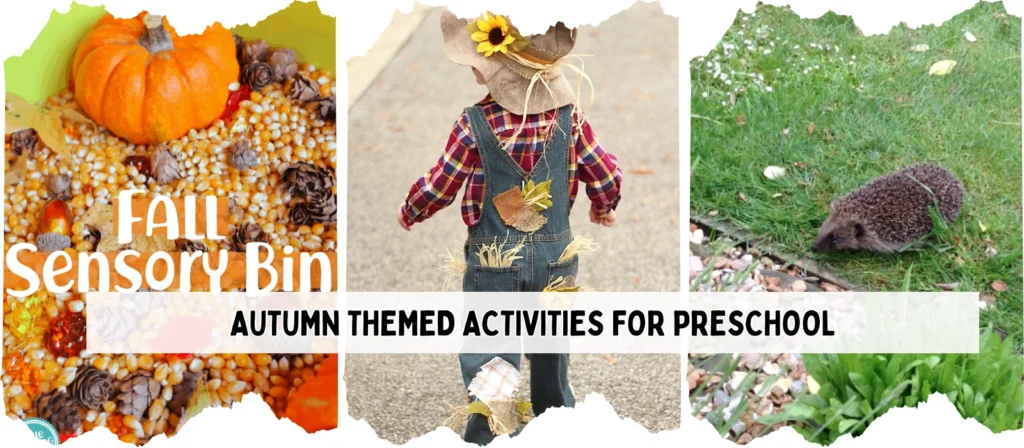
🍁 Fall Sensory Bin
A fall-themed sensory bin is a tactile experience that allows preschoolers to explore the textures, colors, and scents of autumn while improving their fine motor skills and concentration.
- Materials: Dried corn kernels, mini pumpkins, leaves, pinecones, cinnamon sticks, small containers, scoops, tongs
- Steps: Fill a large plastic bin with sensory materials like dried corn and scented items such as cinnamon sticks. Add fall-themed objects like tiny pumpkins, toy squirrels, or felt leaves. Provide tools like scoops, tweezers, and cups to promote pouring, grabbing, and transferring. Children can engage in free play or follow prompts like “Can you find all the red leaves?” This immersive autumn activity for preschoolers enhances language, sorting, and motor development.
🧤 Scarecrow Dress-Up Day
This pretend play activity brings the fall harvest theme to life and encourages self-expression, storytelling, and social interaction.
- Materials: Flannel shirts, overalls, straw hats, scarves, yarn, paper buttons, face paint
- Steps: Set up a dramatic play area with clothing and accessories for children to dress up like scarecrows. Encourage them to make up characters and act out simple stories like helping in the pumpkin patch or protecting a cornfield. Take photos and ask children to describe their character: “What’s your scarecrow’s name?” This is one of the most engaging autumn activities for preschoolers to boost dramatic skills.
🎃 Pumpkin Exploration Station
Pumpkin dissection and exploration integrate sensory learning, science observation, and descriptive language into one exciting fall-themed experience.
- Materials: Whole pumpkins, child-safe knives or scoops, trays, magnifying glasses, gloves, spoons, paper towels
- Steps: Start by examining the outside—texture, color, weight. Then cut open the pumpkin and allow children to touch, scoop, and inspect the inside. Invite them to describe the feel, count the seeds, compare sizes, and draw what they see. This interactive autumn activity for preschoolers introduces basic scientific observation and vocabulary like “pulp,” “seed,” “fibers,” and “hollow.”
🍎 Apple Taste Test and Graphing
This flavorful experiment combines sensory exploration, nutrition education, and basic graphing—all rooted in the autumn season.
- Materials: Red, green, and yellow apples, cutting board, small plates, chart paper, markers
- Steps: Slice apples and let children taste each variety. Encourage them to describe flavors and textures. Create a simple chart to graph their favorites, using apple stickers or colored paper. Discuss the results: “Which color had the most votes?” “Why did you like the red apple?” This autumn activity for preschoolers supports decision-making, comparison, and expressive language.
🦔 Hedgehog Nature Walk & Discussion
A guided nature walk themed around fall animals like hedgehogs helps preschoolers connect to their environment and builds background knowledge about animal habitats and behavior.
- Materials: Storybook about hedgehogs, nature walk checklist, clipboards, crayons
- Steps: Read a story about forest animals preparing for winter. Then go on a walk to observe leaves, acorns, and possible animal signs. Afterward, children draw or describe what they saw. Follow up with a hedgehog craft using pinecones and felt. This thematic autumn activity for preschoolers integrates science, movement, and creative thinking.
Autumn Craft Activities for Preschoolers
Crafting is a joyful and enriching way for preschoolers to develop fine motor skills, practice creativity, and engage with seasonal themes. These autumn activities for preschoolers combine hands-on creation with storytelling, sensory play, and classroom decorating.
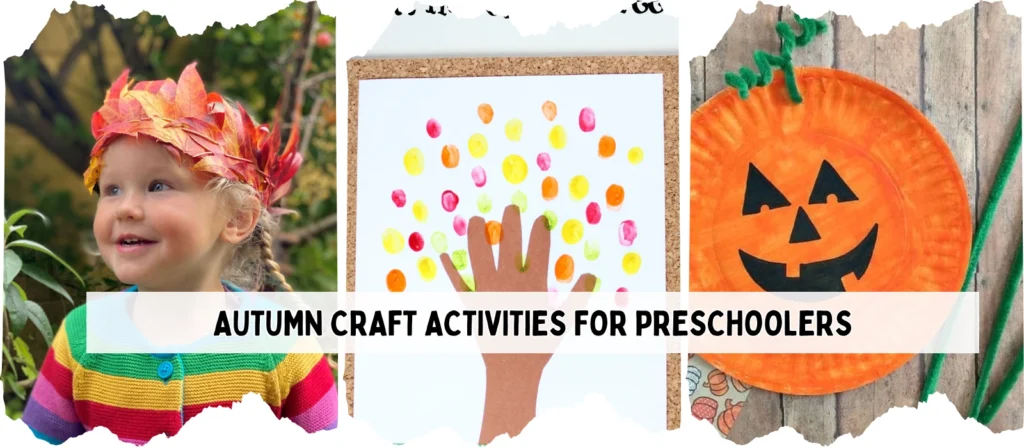
🍂 Leaf Crown Making
This activity allows children to wear the beauty of autumn while practicing sequencing, patterning, and dexterity.
- Materials: Strips of construction paper (headband base), collected leaves, glue, tape, markers, stickers
- Steps: Begin by guiding children on a leaf-collecting walk. Once inside, measure a paper strip to fit each child’s head and tape it into a loop. Help them glue the leaves in a repeating pattern or freestyle design. Add stickers or acorns for decoration. Encourage children to wear their crowns while singing a fall song or parading around the classroom. This autumn craft activity for preschoolers helps connect seasonal change to identity and expression.
🖐️ Handprint Tree Craft
Combining art and personal touch, this craft teaches tree structure and symbolizes growth.
- Materials: Brown and red paint, white paper, brushes, wipes, glue, tissue paper
- Steps: Paint the child’s forearm and hand with brown paint to create the tree trunk and branches. Stamp it onto paper. Then use fingertips or crumpled tissue paper to make fall-colored leaves. Invite children to count the leaves or describe the sound leaves make when they fall. This autumn activity for preschoolers links nature to personal creativity.
🎨 Paper Plate Pumpkin Faces
A fun way to create expressive pumpkin characters and talk about emotions.
- Materials: Paper plates, orange paint, black construction paper, scissors, glue, yarn
- Steps: Paint the plates orange. After drying, cut out shapes for eyes, nose, and mouth using black paper. Children can make happy, silly, or scary pumpkins. Add yarn for stems or hair. Teachers can use this autumn activity for preschoolers as a conversation starter: “What emotion does your pumpkin show?” This supports emotional literacy and artistic expression.
🌻 Harvest Wreath Collage
Making wreaths with fall textures brings together community, design, and sensory experience.
- Materials: Paper plates (cut into ring), fabric scraps, leaves, pom-poms, buttons, glue, ribbon
- Steps: Give each child a paper plate ring and a variety of collage materials. Let them choose and glue their favorite textures to fill the ring. Add ribbon to hang it on walls or doors. Children can describe the items they chose and why. This autumn craft activity for preschoolers emphasizes decision-making and seasonal symbolism.
🐿️ Acorn Necklace Beading
This fine motor craft encourages focus, counting, and creativity.
- Materials: Acorns (drilled or imitation), yarn, beads, safety needles
- Steps: Demonstrate how to string acorns and beads onto yarn using blunt needles. Encourage children to count as they go: “One bead, one acorn.” Create repeating color patterns. Once complete, let them wear the necklaces or use them in dramatic play. Among autumn activities for preschoolers, this one blends nature and number practice seamlessly.
🧤 Felt Leaf Puppets
Create simple leaf-shaped puppets for fall storytelling and dramatic play.
- Materials: Felt in fall colors, googly eyes, glue, scissors, popsicle sticks
- Steps: Pre-cut leaf shapes or help children trace and cut their own. Decorate with eyes and markers, then glue onto sticks. Invite children to name their puppet and use it in a fall story circle. These crafts become props for songs, plays, or counting games, making them versatile autumn activities for preschoolers that support multiple learning domains.
Outdoor Autumn Activities for Preschoolers
Spending time outdoors is essential for preschoolers’ physical development, curiosity, and connection with the natural world. Autumn offers endless opportunities for seasonal discovery and movement. These outdoor autumn activities for preschoolers combine nature-based play with learning outcomes like observation, classification, and cooperation.
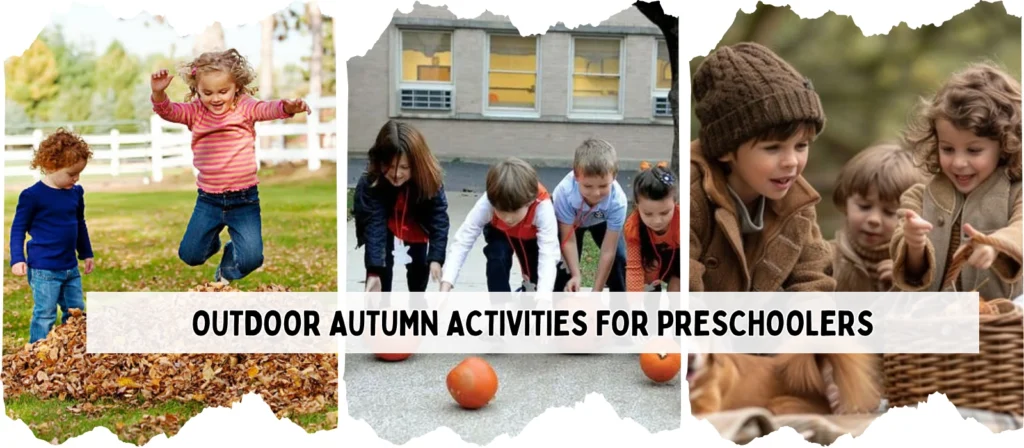
🍁 Nature Scavenger Hunt
This classic autumn activity for preschoolers promotes observation skills and vocabulary building through active exploration.
- Materials: Printable scavenger hunt list (pictures or words), clipboards, crayons, small bags or baskets
- Steps: Prepare a list of fall items to find: red leaf, pinecone, stick, acorn, squirrel, etc. Distribute clipboards and crayons, and encourage children to check off each item as they find it. After the walk, gather to share findings. Teachers can ask, “What was your favorite thing you found?” or “Was there anything missing from your list?” This activity builds attention to detail and environmental awareness.
🐿️ Squirrel Role-Play Game
An energetic, imaginative outdoor game that encourages teamwork and introduces the concept of animal behavior.
- Materials: Plastic acorns or balls, buckets, cones, blindfolds (optional)
- Steps: Scatter “acorns” around a defined outdoor space. Assign roles: squirrels must collect and store acorns before “winter” arrives. You can set a timer to add excitement. To enhance the challenge, add a memory component by hiding the acorns and having children return to find them. This autumn activity for preschoolers reinforces counting, strategy, and cooperative play.
🍂 Leaf Pile Jump
A joyful activity that builds gross motor skills and introduces seasonal change.
- Materials: Large piles of clean, dry leaves, rakes, safe jumping area
- Steps: After raking leaves into soft piles, let children take turns jumping into them. Set rules for safety and invite children to describe how the leaves feel, sound, and smell. Use this activity as a launchpad to talk about why trees shed their leaves and what happens in autumn. This is one of the most physical and sensory-rich autumn activities for preschoolers.
🎯 Pumpkin Rolling Races
This activity combines motor planning, coordination, and laughter—perfect for preschoolers’ outdoor energy.
- Materials: Small pumpkins (roundish), cones or start/finish markers, chalk
- Steps: Create a racecourse and assign teams or pairs. Children must roll—not throw—the pumpkins from start to finish. Encourage cheering and team spirit. Teachers can use a timer or measure the distance rolled. This autumn activity for preschoolers builds balance, teamwork, and fair play.
🪵 Stick Obstacle Course
Use natural materials to set up a creative course that builds physical and spatial awareness.
- Materials: Sticks, logs, stones, cones, hula hoops
- Steps: Arrange stations: stepping over sticks, crawling under a log, jumping into leaf rings, balancing on stones. Walk through the course as a group first, then let children repeat at their own pace. Prompt them to describe what was easy or tricky. Among autumn activities for preschoolers, this one promotes confidence and resilience through physical challenges.
🧺 Autumn Picnic & Storytime
A calming yet enriching activity that combines outdoor dining with literacy.
- Materials: Blankets, healthy fall snacks, storybooks about autumn, water bottles
- Steps: Choose a shady spot under a tree or near the playground. Invite children to help set up picnic blankets. Serve seasonal fruits like apples or pears and read a fall-themed book aloud (e.g., Leaf Man or The Busy Little Squirrel). Afterward, encourage children to retell parts of the story or act it out. This outdoor autumn activity for preschoolers connects nutrition, language, and relaxation.
Autumn Learning Activities for Preschoolers
Autumn is a season rich in teachable moments, making it an ideal time to incorporate academic skills into everyday play. These autumn learning activities for preschoolers blend literacy, science, and cognitive development with the excitement of seasonal change. By focusing on real-world connections, teachers can foster curiosity and deepen children’s understanding through purposeful play.
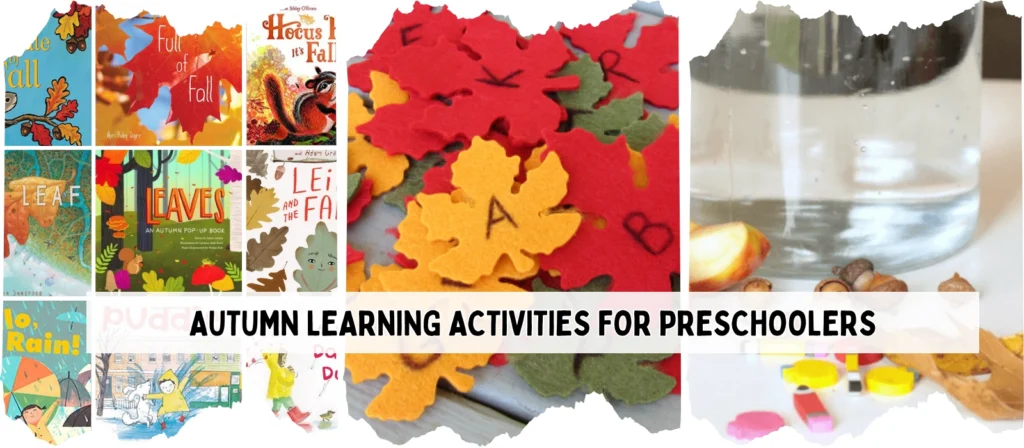
📖 Fall Story Time with Books
Reading fall-themed stories helps build vocabulary, listening comprehension, and imagination.
- Materials: Picture books about autumn (e.g., Fletcher and the Falling Leaves, We’re Going on a Leaf Hunt), soft seating or story rug
- Steps: Choose a quiet corner of the classroom or reading tent outdoors. Introduce the book by discussing the title, cover illustrations, and asking children what they know about autumn. During reading, pause to highlight key vocabulary such as “migration,” “harvest,” or “bare trees.” Ask predictive and reflective questions to stimulate comprehension. After reading, encourage children to act out a favorite scene, draw a character, or dictate their own version of the ending. This autumn learning activity for preschoolers builds a love for books while reinforcing comprehension, narrative sequencing, and expressive language.
🍁 Letter Recognition with Leaves
This activity combines nature and early literacy in a multisensory format.
- Materials: Paper leaves labeled with uppercase and lowercase letters, clothespins, string, baskets
- Steps: Scatter letter-labeled leaves around the classroom or playground. Invite children to search for letters and sort them into baskets or clip them onto a string alphabet line. For variation, challenge them to match uppercase to lowercase or find the first letter of their name. Discuss letter sounds and form simple words using found letters. Incorporate songs or chants for letter reinforcement. This autumn activity for preschoolers supports phonics, memory, and physical engagement, especially valuable for kinesthetic learners.
🍎 Science Observation Journals
Help children become scientists as they observe the world changing around them.
- Materials: Small notebooks or printable journal pages, crayons, pencils, magnifying glasses
- Steps: Introduce the idea of being a “leaf scientist” or “weather reporter.” Guide children to document daily or weekly outdoor observations—tree color changes, falling leaves, migrating birds. Encourage them to draw details and dictate notes if writing is a challenge. Use magnifying glasses to inspect objects like bark or acorns. Review journals together in group discussions. This autumn learning activity for preschoolers enhances descriptive language, critical thinking, and builds early scientific inquiry skills.
🧠 Autumn Alphabet Game
A fun, movement-based way to reinforce alphabet knowledge and gross motor skills.
- Materials: Large laminated leaves with letters, music player
- Steps: Lay letter leaves on the floor in a large circle or scattered across the room. When music plays, children move around, jump like squirrels, or tiptoe through the “forest.” When the music stops, each child stands on a leaf, says the letter, its sound, and a word that starts with it. You can scaffold by giving hints: “Find the letter that starts ‘pumpkin.’” This autumn activity for preschoolers supports letter recognition and oral vocabulary development through movement and fun.
🔤 Rhyming Word Apple Tree
An interactive language game that reinforces phonemic awareness.
- Materials: Apple cutouts with rhyming words, felt board or paper tree, Velcro or tape
- Steps: Prepare apple cutouts with simple rhyming words (e.g., cat/hat, log/frog, tree/bee). Place a blank apple tree on a board or wall. As you call out base words, children find the rhyming match and place their apple on the tree. Group discussion follows: “What other words rhyme with hat?” Add movement by hiding apples for a rhyme hunt. This autumn learning activity for preschoolers strengthens sound recognition, word families, and oral language.
🧪 Sink or Float: Fall Objects Edition
Encourage scientific thinking and hypothesis testing through seasonal materials.
- Materials: Tub of water, leaves, twigs, acorns, apples, small pumpkins, towels
- Steps: Gather seasonal items and present them one at a time. For each, ask children to predict: “Will it sink or float?” Encourage reasoning: “Why do you think the apple will float?” Children place objects in the tub and observe results. Record data with visual charts or stickers. Discuss concepts of density and weight in age-appropriate language. This autumn activity for preschoolers introduces early STEM learning in a playful and sensory-rich context.
How to Create a Thematic Autumn Classroom Environment
Creating a thematic classroom environment tailored to the season can significantly enhance the effectiveness of autumn activities for preschoolers. A well-designed autumn space immerses children in the sights, sounds, and textures of the season, making learning more tangible and memorable. More than just decoration, a thematic environment supports intentional learning by embedding key developmental goals into every corner of the classroom.
To begin, educators should focus on natural materials and seasonal colors—reds, oranges, yellows, and browns. Incorporate real leaves, pumpkins, gourds, branches, straw bales, and pinecones throughout the classroom. Use these not only in craft areas but also in literacy corners, math manipulatives, and dramatic play zones. The goal is to make the classroom itself part of the lesson, a living, breathing reflection of autumn activities for preschoolers.
Create a seasonal sensory corner filled with fall textures like dried corn, burlap, cinnamon sticks, and crunchy leaves. Add a quiet reading nook with fall-themed pillows, plush animals, and a basket of autumn books. Hang leaf garlands and use window clings in fall shapes to transform the atmosphere. These changes not only reinforce seasonal vocabulary but also offer a cozy and calming space conducive to emotional development—especially important during transition periods.
Bulletin boards and classroom displays are another opportunity to extend autumn activities for preschoolers. Feature artwork created during seasonal crafts, nature photos children take on outdoor walks, or collaborative murals like a “Fall Tree of Feelings” where children place a leaf labeled with how they feel each day. These displays help children connect to the theme while practicing self-expression and group belonging.
Additionally, bring autumn into your daily routines. Use leaf and pumpkin-themed name tags, weather charts, and calendar numbers. Sing seasonal transition songs when cleaning up or lining up. Integrate autumn themes into circle time conversations, snack choices (apple slices, roasted pumpkin seeds), and even movement breaks with leaf-dancing or pretend animal migration.
By thoughtfully curating an environment that supports autumn activities for preschoolers, teachers can amplify the season’s educational impact. Thematic classrooms help children feel grounded in time and place, enrich sensory and language experiences, and provide countless opportunities for spontaneous learning moments throughout the day.
Using Autumn Activities to Support Montessori and Reggio Approaches
Autumn activities for preschoolers naturally align with two of the most respected early childhood education models: the Montessori method and the Reggio Emilia approach. Both pedagogies emphasize hands-on, child-centered learning—making autumn an ideal season for experiential and meaningful engagement across developmental domains.
In Montessori classrooms, learning is structured around purposeful work with real-life materials. Autumn activities for preschoolers fit seamlessly here, as they involve natural materials, sensory discovery, and independent choice. A child may use tongs to transfer acorns into labeled bowls, practicing fine motor control and one-to-one correspondence. Or, a leaf-matching tray can introduce children to concepts of size, shape, and classification—all through self-directed, tactile exploration. These autumn-themed works reflect the Montessori principle of “learning by doing.”
Montessori’s emphasis on the prepared environment is also enriched by autumn activities for preschoolers. Teachers can organize shelves with rotating seasonal work trays: pumpkin washing, leaf sorting, gourd polishing, or apple slicing. Each task is grounded in real-world experience and fine motor development. Importantly, these works also teach sequencing, responsibility, and independence. The calming rhythm of repeated autumn activities for preschoolers nurtures focus and builds confidence in young learners.
In the Reggio Emilia approach, children are viewed as capable, curious collaborators. Autumn becomes a provocation for inquiry and creative expression. Instead of pre-planned crafts, Reggio-inspired autumn activities for preschoolers begin with open-ended materials—baskets of leaves, sticks, seeds, or shadows cast by bare branches. Teachers observe children’s interactions and document emerging interests, guiding the learning path organically.
For example, children collecting leaves during outdoor exploration may later choose to categorize them, create symmetrical designs, or tell a story through their arrangement. These autumn activities for preschoolers become vehicles for language development, group dialogue, and personal storytelling—hallmarks of Reggio practice. Class projects such as building a collaborative fall sculpture or mapping a tree’s seasonal changes honor the Reggio value of co-construction of knowledge.
Both approaches embrace natural rhythms and seasons as central to the child’s learning experience. Autumn activities for preschoolers offer rich opportunities to introduce scientific thinking, foster independence, and promote creativity without rigid outcomes. Whether a Montessori guide or a Reggio-inspired educator, aligning your classroom practices with seasonal exploration affirms the child’s role as an active participant in their own learning journey.
By thoughtfully designing autumn activities for preschoolers that reflect the principles of Montessori and Reggio, educators create classrooms where curiosity, discovery, and development thrive in harmony with the season.
Tips for Planning Safe and Inclusive Autumn Activities for Preschoolers
Planning autumn activities for preschoolers involves more than creativity and curriculum alignment—it also requires a strong focus on safety and inclusion. To ensure all children benefit from fall-themed learning, educators must consider environmental factors, diverse abilities, cultural backgrounds, and emotional well-being when designing autumn activities for preschoolers.
Outdoor Safety Considerations
Safety comes first, especially in outdoor autumn activities for preschoolers. As leaves pile up and the ground gets damp, slipping hazards increase. Always inspect outdoor play areas before use, remove tripping obstacles like wet branches, and ensure equipment such as slides and climbing frames are dry and stable. When planning nature walks or leaf hunts, educators should bring first aid kits, use a buddy system, and review boundaries with the children beforehand.
Weather Preparation and Flexibility
Weather can shift quickly in autumn, so always prepare for changes in temperature. Send reminders to families about appropriate fall clothing—layers, waterproof shoes, hats—and keep a few spare jackets or mittens on hand. Plan flexible indoor versions of key autumn activities for preschoolers, such as a simulated nature scavenger hunt or a classroom leaf pile, so that learning continues even on rainy days.
Inclusive Activity Design for All Learners
Inclusivity is just as essential. When designing autumn activities for preschoolers, ensure every child—regardless of ability—can participate meaningfully. Use multi-sensory materials to support children with visual or sensory needs, and provide adaptive tools like chunky crayons or Velcro-attached visuals. For children with mobility challenges, bring fall elements into the classroom for seated engagement or sensory tables. Build in multiple entry points so each child can contribute to group projects or storytelling.
Culturally Responsive Planning
Cultural responsiveness is also a key component of inclusive fall programming. Some families may not celebrate harvest festivals or Halloween. Instead of centering activities on holidays, focus on seasonal themes like leaves, apples, weather changes, and animal migration. This allows all children to engage in autumn activities for preschoolers without conflicting with their family values.
Emotional Safety and Transitions
Finally, consider the emotional needs of young children. Fall often marks the start of school, and transitions can be overwhelming. Autumn activities for preschoolers that emphasize rhythm, repetition, and calm—like daily leaf songs or predictable fall-themed routines—help establish a sense of security. Use visual schedules, gentle transitions, and supportive language to make seasonal learning joyful and anxiety-free.
By embedding safety checks and inclusive design into every plan, educators can ensure their autumn activities for preschoolers are not only engaging but also accessible, respectful, and developmentally appropriate for every child in their care.
Conclusion
At XIHA Furniture, we believe autumn activities for preschoolers should be more than just seasonal entertainment—they should be powerful, inclusive tools that promote development and joyful learning across all domains. From exploring nature trails to crafting leaf crowns, every autumn activity for preschoolers can support fine motor skills, literacy, cognitive exploration, and social-emotional growth.
As a trusted global supplier of preschool furniture and educational tools, we support educators with high-quality, affordable, and child-safe materials designed to enhance the classroom experience. Whether you’re organizing Montessori-inspired learning trays or Reggio-based nature provocations, our product solutions ensure your autumn activities for preschoolers are not only effective but beautifully integrated into your space.
The versatility of autumn activities for preschoolers means they can be adapted across philosophies, budgets, and learning styles. The key is creating opportunities that meet children where they are, reflect their curiosity, and invite them to explore the world around them.
With thoughtful planning, safe spaces, and developmentally appropriate tools—like those we offer at XIHA Furniture—you can design meaningful autumn activities for preschoolers that make this season one of wonder, warmth, and discovery.
Let the leaves fall, the stories unfold, and the learning flourish.

